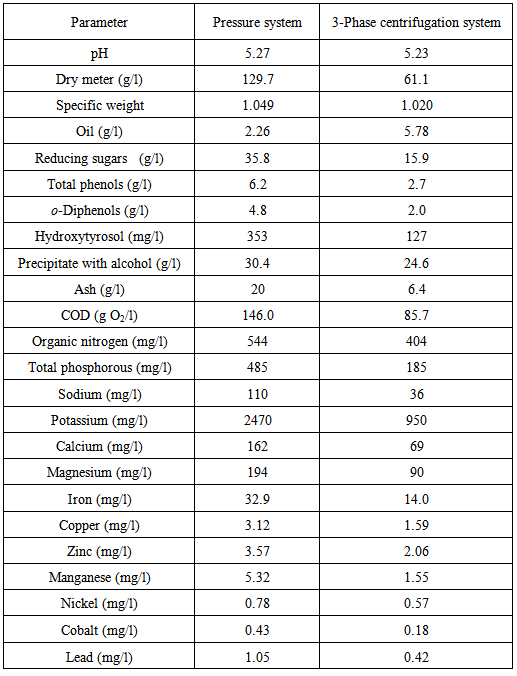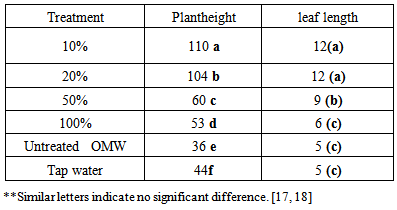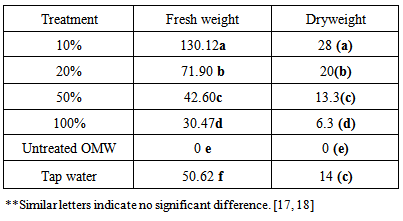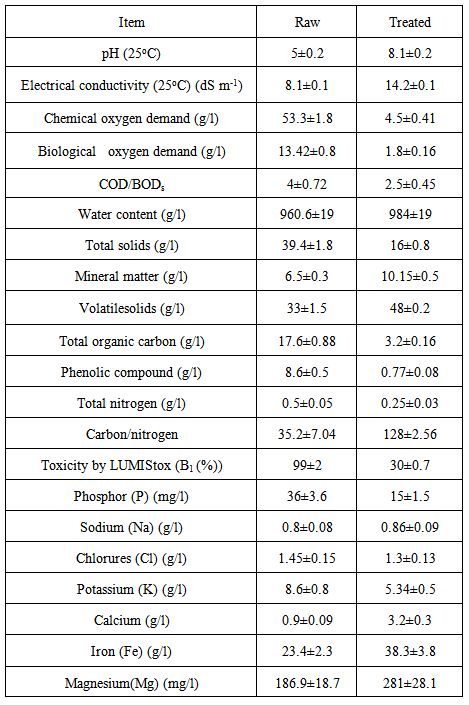-
Paper Information
- Previous Paper
- Paper Submission
-
Journal Information
- About This Journal
- Editorial Board
- Current Issue
- Archive
- Author Guidelines
- Contact Us
International Journal of Agriculture and Forestry
p-ISSN: 2165-882X e-ISSN: 2165-8846
2014; 4(4): 304-309
doi:10.5923/j.ijaf.20140404.07
Scope of Using Treated Olive Mill Wastewater in Tomato Production
Hazem Sawalha1, Orwa Houshia2, Anan Hussein3, Qasim Mahariq1, Abdallah Khader1
1Department of Biology and Biotechnology
2Department of Industrial Chemistry
3Department of Physics /Arab American University, Jenin, Palestine
Correspondence to: Orwa Houshia, Department of Industrial Chemistry.
| Email: |  |
Copyright © 2014 Scientific & Academic Publishing. All Rights Reserved.
An experiment was carried out to evaluate the feasibility of using treated olive mill wastewater (OMW) in irrigating tomato crops. The OMW was filtrated using a home-made filter of a matrix that mimics nature. OMW filtration improved physical and chemical properties of the filtrate as it became clear with neutral pH. The results showed that the 10% dilution of the filtrate gave best results compared with those irrigated with tap water. The 20% dilution gave the second best outcome followed by the 50% which gave an intermediate plant growth and production. Irrigation with untreated OMW killed the plants in a couple of days. Treated OMW was found to be useful in irrigating tomato crops at economic level.
Keywords: Olive mill wastewaters, Tomato, Irrigation, Agriculture
Cite this paper: Hazem Sawalha, Orwa Houshia, Anan Hussein, Qasim Mahariq, Abdallah Khader, Scope of Using Treated Olive Mill Wastewater in Tomato Production, International Journal of Agriculture and Forestry, Vol. 4 No. 4, 2014, pp. 304-309. doi: 10.5923/j.ijaf.20140404.07.
1. Introduction
- Olive mill waste water (OMW) is defined as the liquid waste produced during olive oil production. It consists of water soluble macromolecules such as, tanen, polyphenols, polyalcohols and polymers. OMW also contains an insoluble matter like cellulose, pectin and oil. Especially because of the dangerous effect of phenols in OMW, phenols must be removed to reduce pollution. The quantity of OMW produced in the process ranges from 0.55 to 2 liters perkilogram of olives, depending on the oil extraction process. The manufacturing process of the olive oil usually yields next to olive oil (20%), a semi-solid waste (30%), and aqueous liquor (50%). The aqueous liquor comes from the vegetation water and the soft tissues of the olive fruits. The mixture of this water-based by-product with the water used in the different stages of oil production makes up the so-called ‘‘olive-mill waste water’’ (OMW). Furthermore, olive washing water, waters from filtering disks, and from washing of equipment and rooms are to be included into this wastewater [1].Because of this, the OMW treatment is very important for Palestine and for the other producer countries that deal with OMW and olive oil extraction. The content and amount of OMW depends on the maturity of the fruit, the trees, the agricultural methods for growing the trees, the quality of the soil, climate and especially to the kind of olive oil process system. Treatment methods of OMW can be classified as physical, chemical, biological and all combination where these techniques are used together. Main examples are aerobic, anaerobic treatments, filtration, flocculation, wet-oxidation, evaporation and adsorption. Phenols in the OMW are resistant to bio degradation, they cause inhibition and toxicity because of this they are tried to be adsorbed on a surface. The bioactivity and analysis of OMW bio phenols has been Reviewed [15].From an environmental point of view, OMW is the most critical waste emitted by olive-mills in terms of both quantity and quality. In view of this, it is apparent that an olive waste must be treated and preferably utilized. Up to now the emphasis has been on detoxifying OMW prior to disposal. However, the present trend is towards further utilization of OMW by recovering useful by-products. Essentially, the OMW composition is water (80–83%), organic compounds (15–18%), and inorganic compounds (mainly, potassium salts and phosphates) 2%, and it varies broadly depending on many parameters such as olive variety, harvesting time, climatic conditions, and oil extraction process. The presence of large amounts of proteins, polysaccharides, mineralsalts, and other useful substances for agriculture, such as humic acids, OMW hasa high fertilizing power. Therefore, OMW can serve as natural, low-costfertilizer available in large amounts. [2, 3] Unfortunately, besides these useful substances for agriculture, OMW also contains phytotoxic and bio-toxic substances, which prevent it from being disposed off. The phytotoxic and antibacterial effects of OMW have been attributed to its phenolic content. Phenolic compounds are present in OMW at concentrations in the range from0.5 to 24 g/L, and are strictly dependent on the processing system used for olive oil production. A group of phenolic compounds found in OMW are derived from cinnamicacid: the parent unsubstituted cinnamic acid, o- and p-coumaric acid (4-hydroxycinnamic acid), caffeic acid (3, 4dihydroxycinnamic acid), and ferulicacid (4-hydroxy-3- methoxycinnamic acid). [14] Another group of phenolic compounds found in OMW are derived from benzoic acid: the parent unsubstituted benzoicacid, protocatechuic acid, and b-3,4-dihydroxyphenyl ethanol derivatives, such astyrosol and hydroxytyrosol. [5] Another group of phenolic compounds found in OMW are derived from benzoic acid: the parent unsubstituted benzoicacid, protocatechuic acid, and b-3,4-dihydroxyphenyl ethanol derivatives, such astyrosol and hydroxytyrosol. [5] Other phenols found in OMW include catechol, 4-methylcatechol, p-cresol, and resorcinol. [6]Some of the characteristic parameters carried out on fresh OMW samples obtained from olive-mills processing olives by pressure and 3-phase centrifugation systems is shown in Table 1. [4]
|
2. Materials and Methods
- OMW sourceThe OMW was collected from different automated olive mill from Jenin governorate and transferred to the chemistry lab of the Arab American University, Jenin (AAUJ). The olive mill waste aqueous solutions were obtained from three –phase centrifugal extraction mills. For sedimentation of solid impurities, the OMW was left for an overnight period at room temperature.Filter Preparation The filter was prepared using six layers of different natural materials as shown in Figure 1.
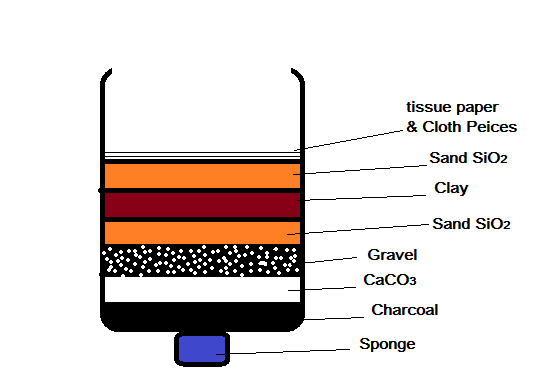 | Figure 1. The matrix content of the home-made filter |
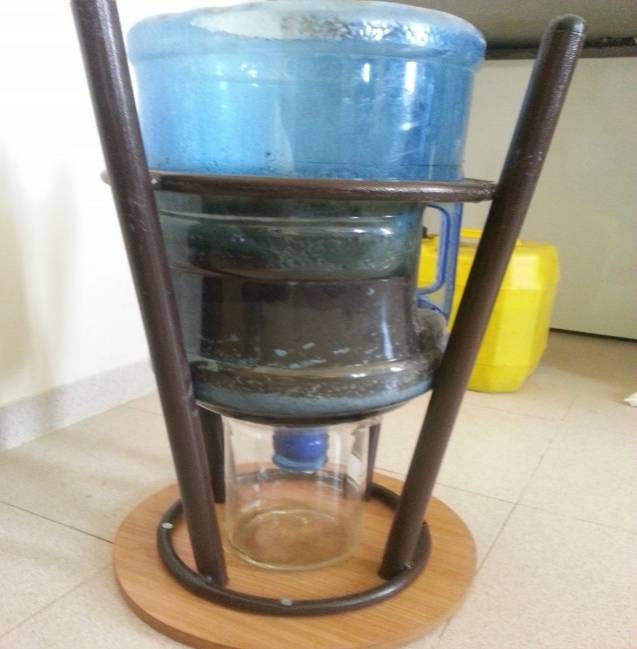 | Figure 2. The home-made filter showing the process of filtration |
3. Results
- Filtrate properties A clear filtrate was obtained with yellowish color without any apparent impurities. The pH of the filtrate was 7.12 compared with 4.60 for the untreated OMW as shown in Figure 3. Furthermore the filtrate was characterized with a pungent odor.
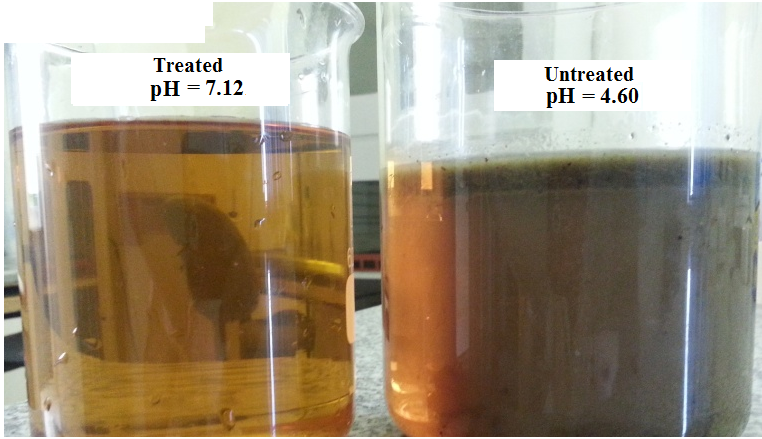 | Figure 3. Comparison of clearance of treated and untreated OMW |
|
|
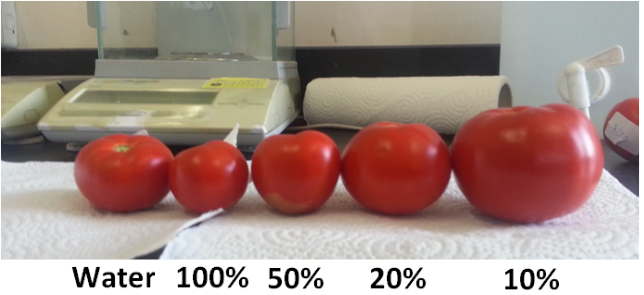 | Figure 4. Fruit size and quality irrigated with OMW |
 | Figure 5. Growth and development of tomato plants irrigated with OMW |
4. Discussion
- Water resources in Palestine are under tremendous stress due to several reasons including increasing demand on fresh water, political situation and population growth. In addition, natural and man-made issues may increase the seriousness of water scarcity in the country. Because of its geographical location (semi-arid), Palestine receives an average of 300 - 400 mm of water yearly. Misuse is also another problem. The country is urgently in need of alternative options toward water management and wastewater treatment. This requires shifting from the use and disposing approach to the use, treat, and reuse approach. The current experiment proposes a set of alternatives for sustainable water management in the agricultural sectors in the West Bank that alleviate the stress on water resources. Implementing a combination of water management alternatives that will put water management in the West Bank in Palestine on a sustainable track. [7-9]In this research, OMW was filtered through a specially designed apparatus and the collected filtered water was made into various dilutions. Each dilution was dosed to tomato plants and the influence and progress on these plants were monitored. It was noticed that plants irrigated with 10% and 20% dilutions were the best as they had strong structure, greenest leaves, longest stem and the longest leaves. Plants irrigated with 50% dilution were less tall. Irrigation with 100% filtrate produced plants shorter than the plants irrigated with lower dilutions but stronger than the once that irrigated with tap water. This is mainly that the filtrate may contain elements that promoted growth of the plants. Another reason is that the filtrate may contain some polyphenols that have antiseptic activities and anti-oxidant properties.The polyphenols, specifically hydroxytyrosol and catechol are responsible for many biological effects, including antibiosis, ovipositional deterrence and phytotoxicity. Of all the polyphenols considered, hydroxytyrosol, is worth noting as the main natural polyphenolic compound in OMW. Possibly it arises from the hydrolysis of oleuropein by an esterase during the milling process (see Figure 6). Hydroxytyrosol is characterized by major bio-antioxidant activity. Hydroxytyrosol is one of major phenolic compounds present in olive fruit and it has been revealed to be the most interesting, because of its remarkable pharmacological and antioxidant activity. hydroxytyrosol has variety of applications: as natural food antioxidant, preparation of functional foods, pharmaceutical solutions or cosmetics. Oleuropein has been considered a valuable component with certain antiviral, antibacterial, antifungal, antioxidant and anti-inflammatory properties (Fig.1) [10, 11].
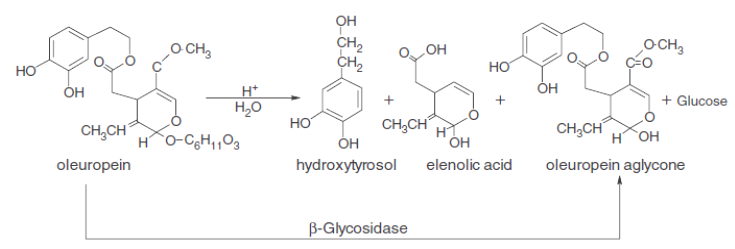 | Figure 6. The structure of oleuropein and its hydrolysis products |
|
5. Conclusions
- Olive mill wastewater constitutes a hazardous environmental problem. A simple treatment filter proposed to treat their contaminant impacts. Soils in semi-arid and arid areas are known to have low organic matter levels, a low fertility and a high exposure to degradation, desertification and pollution. Treated olive mill wastewater may contain relatively good nutrients for plants as well as an important volume of water and a potential use as a fertilizer, especially for soils and crops.Finally, the physical method that was used in this experiment is cheap and easy to use everywhere. The plants that were irrigated with high concentrations of filtrate were weaker than those were irrigated with low concentrations; because that high concentration has some toxic materials in low concentrations.
 Abstract
Abstract Reference
Reference Full-Text PDF
Full-Text PDF Full-text HTML
Full-text HTML